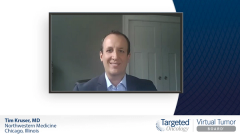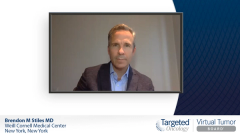
Case 3: Molecular Testing in Stage III NSCLC
Episodes in this series

Brendon M. Stiles, MD: A bronchoscopy was performed, and a transbronchial lung biopsy of the right upper lobe mass was performed. This showed adenocarcinoma, and the bronchoscopist was able to biopsy 4R and 7 and confirmed that those were also metastatic nodal disease. They did make an effort to sample the 4L, which was negative. The final clinical stage here was T2aN2M0, stage IIIA. Then based on the bulk and the extent of the mediastinal disease and the active emphysema, the patient’s cancer was deemed to be unresectable, or shouldn’t resect, and he was referred for consideration of concurrent chemotherapy and radiation.
Mark Socinski, MD: Ed, your thoughts about molecular testing in this stage III disease? Do you routinely do it?
Edward Kim, MD: I would say that prior to maybe about a month and a half ago, we were just testing in stage IV patients, although we had reflex testing set up with any lung cancer diagnosis. I would say that there’s been some change in the paradigm, and we are now doing molecular testing on everyone. However, if we knew that they were specifically a stage IIIB, unresectable, undergoing concurrent chemoradiation, there are no standard biomarkers we would utilize to make any treatment decisions here.
Mark Socinski, MD: Patients with advanced stage III disease end up being stage IV, and it would be pertinent to know at that point. Again, I don’t know that we have any data to date that suggest that we should act on whatever we find from molecular testing, at least in this stage III disease. Obviously, ongoing trials may change that, and of course we all saw the ADAURA trial, so we may all be testing early stage disease, but that’s a subject for a different day. Options for treatment, we’ve already decided this patient is not a surgical candidate. I think we spent the 1990s and early 2000s showing that concurrent chemoradiotherapy is the standard of care and not sequential. I think we can move on and let Dr Kruser address the next step and considerations from a radiation oncology perspective.
Tim Kruser, MD: Yes, I think that’s a great introduction. Thank you. As you pointed out, concurrent chemoradiotherapy was established by a trial that was launched in 1994. We’re going to talk a little bit more about how we treat now, both in the setting of RTOG 0617, which is a dose-finding trial, and then touch upon the PACIFIC trial, which has really changed practice. There are a few questions here about how we keep patients optimized, especially now in light of the PACIFIC data, and wanting to make sure they’re in good condition to get on to durvalumab. I would highlight the role for multidisciplinary care in this setting. We as radiation oncologists really rely on our nurses, who are really vital in helping keeping these patients fit through chemoradiotherapy, as well as our nutrition colleagues. When we run into esophagitis, keeping good hydration and caloric intake is very important. Furthermore, social work is actually underrecognized, an important player for people receiving chemoradiotherapy. Treatment breaks for transportation issues related to 6 weeks of chemoradiotherapy can be an unrecognized problem for these patients. So a lot of times our social workers are very important for helping to facilitate that. We’ll talk a little bit more about some of the radiation data, per se.
Transcript edited for clarity.










































